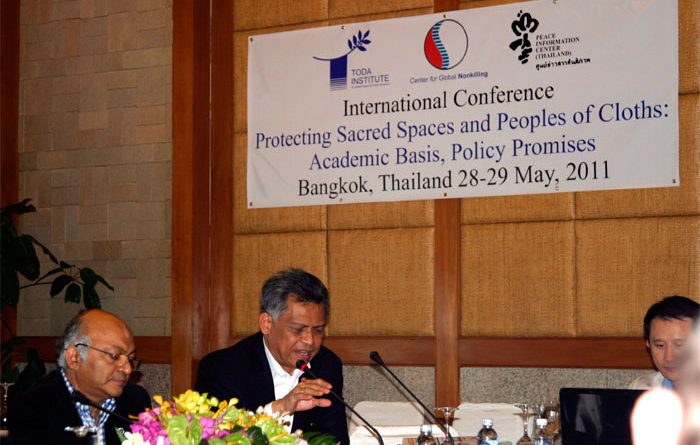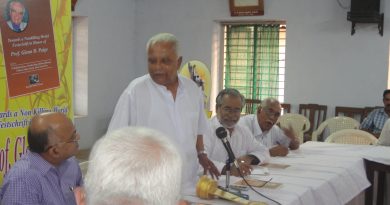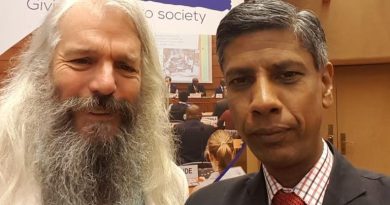Violence against sacred spaces a rising global threat
By Chaiwat Satha-Anand.
On Aug 6, neo-Nazi Wade Michael Page walked into the gurudwara (Sikh temple) of Oak Creek, Wisconsin and murdered six people, including the temple president, before he was shot dead by police.
While Sikhs in the United States have suffered from discrimination since they started coming to the US in the early 20th century –they were driven out of Bellingham, Washington, in 1907 and out of St John, Oregon in 1910– this most recent killing in Wisconsin sparked a global outcry from Washington DC to New Delhi. In India, members of Sikh communities staged protests in several cities including New Delhi and Jammu, Kashmir.
There are many ways to understand this abominable incident. Page’s personal history of associating with far-right groups and his psychological profile would be one way.
The violent history of America, with its prevalent gun culture –including the recent mass killing at the screening of The Dark Knight Rises at a Denver cineplex on July 20, which claimed 12 lives– would be another.
Situating this case in the larger context of the growing number of hate groups in the US would be yet another way.
According to the Southern Poverty Law Center, there are now 1,018 hate groups in the US, a 69% increase since the beginning of the 21st century.
There is also a resurgence of the anti-government “Patriot” movement, which includes groups with armed militias. Its membership soared by 775% during the first three years of the Obama administration, from 149 in 2008 to 1,274 in 2011.
In Wisconsin alone, there are eight hate groups including the neo-Nazi “New Order” in Milwaukee, “Crusaders for Yahweh” in Eau Claire and “Aryan Nations 88” in Green Lake, among others. Situating the Wisconsin killing in the American context is certainly important, but I would argue that the case is much more dangerous if viewed in the global context of a heinous trend conducive to deadly religious-ethnic conflicts –that of violence against sacred spaces which includes killing worshippers in their houses of worship.
This article attempts to show that there is indeed such a trend of violence against sacred spaces and that to cope with such a phenomenon, it is important to understand why violence against sacred spaces is dangerous.
An emerging global trend?
In southern Thailand, there have been cases of violence against sacred spaces and religious personnel since the new round of violence reignited in 2004.
Two of the most significant cases were the killings of 10 Malay Muslims, including the imam, while they were praying in the Al-Furqan mosque in Narathiwat on June 8, 2009; and the bomb attack that killed two Buddhist monks from Suan Kaew temple while they were making their daily rounds of alms-begging under military protection on a road in Yala on May 16, 2011, one day prior to the most important date on the Buddhist calendar, Visakha Bucha Day.
Incidents such as these prompt me to ask if they are isolated cases or symptomatic of a global trend.
In 2010, I conducted a study on the issue of violence against sacred spaces covering 2009-2010.
I found that there have been 104 incidents related to sacred spaces and religious personnel around the world –49 took place in 2009 and the number rose to 55 in 2010.
In 2010, the number of people killed in incidents related to sacred spaces increased by 19.8% and those wounded rose by 29.1%.
These incidents combined have killed 1,730 people and wounded 3,671.
Most of these incidents took place in Iraq and Pakistan which together accounted for 77.2% of the casualties in 2009 and 71.2% in 2010.
If one considers the fact that Iraq has been in a state of war and Pakistan has not, it is important to point out that the number of people killed and wounded in Pakistan is 33.8% more than the number of casualties in Iraq in relation to sacred spaces and religious personnel.
The year 2010 saw a dramatic increase of 147% in the number of casualties in Pakistan resulting from violence against sacred spaces and religious personnel compared to 2009 (Peace & Policy 17, forthcoming 2012).
In addition, a cursory glance at what has happened to sacred spaces in the first six months of 2012 yields the following results:
- January/People’s Republic of China: More than a thousand Northwest Muslims fought against the Chinese police who demolished their mosque in the Ningxia autonomous region (Bangkok Post, Jan 3, 2012).
- February/Thailand: suspected insurgents threw two M79 grenades into a Buddhist temple in Southern Thailand to avenge the earlier killings of four Malay Muslims by Thai rangers (Bangkok Post, Feb 2, 2012).
- March/Australia: the white supremacy symbol “KKK” and “white power” were scrawled across a wall and several headstones were vandalised at the Fingal Head Cemetery, a burial ground for Aborigines in New South Wales (Bangkok Post, March 9, 2012).
- April/Sri Lanka: Buddhist monks led an angry protest calling for the government to demolish or move a mosque in Dambala, north of Colombo (Bangkok Post, April 24, 2012).
- May/Jerusalem: Vandals, believed to be ultra-orthodox Jews armed with hammers, caused serious damage to a 4th century synagogue in the town of Tiberias on the shore of the Sea of Galilee (Bangkok Post, May 31, 2012).
- June/Iraq: Coordinated bombings and shootings took place during a major Shi’ite religious commemoration killing at least 59 people and wounding more than 200 in and near Baghdad (Bangkok Post, June 14, 2012).
Each case needs to be construed in context of the dynamics of its own local conflict.
But taken together, what these incidents mean is that violence against sacred spaces could happen anywhere; the targets could belong to any religion or belief system; the perpetrators could be organised or spontaneous; and the violence that took place could be either provocative or reactive.
Moreover, some of these cases engender deadlier violence.
For example, recent explosions at three churches in Kaduna, northern Nigeria, that killed at least 16 people. Very soon this incident led furious Christians to retaliate against Muslims in a subsequent riot that killed at least 45 and wounded more than 100 (Bangkok Post, June 19, 2012).
The use of violence against sacred spaces that has occurred around the world is possible precisely because of the uncertainty of the cultural line separating the sacred from profane spaces. When these sacred spaces are attacked, it is their sanctity that generates cultural power and collective identity, often times through moral outrage.
Because of this complex conditionality, Muslims, Christians or Buddhists, among others, who witness their places of worship attacked, react with outrage, and at times with vengeful violence.
One of the reasons why attacking these targets endowed with religious symbolism can be extremely dangerous, making conflicts even deadlier, is because the acts are perpetrated not against individuals but an entire community.
The site that hurts is not the body or physical entity but the self –at times the collective self.
Through the anger of those communities of faith attacked –a kind of moral outrage as evident in Nigeria and elsewhere– violence against sacred spaces oftentimes make conflicts deadlier and intractable.
As a result, this kind of conflict becomes increasingly difficult to resolve.
Anticipating such incidents which seem to occur with increasing frequency, the Toda Institute for Global Peace and Policy Research, together with the Center for Global Nonkilling in Honolulu, the Berghof Foundation, and the Peace Information Centre in Bangkok, organised an international conference on “Protecting Sacred Spaces and Peoples of Cloths: Academic Basis, Policy Promises” in Bangkok on May 28-29, 2011.
The conference explored a specific class of ethno-religious conflict when perpetrators target sacred symbols and peoples, especially religious, which usually render existing conflicts deadlier and/or much more difficult to cope with.
At the conclusion of the conference, international scholars and policy makers in attendance, including the eminent secretary-general of Asean, Dr Surin Pitsuwan, seemed to agree that this issue is indeed a dangerous global problem rarely touched on by researchers.
Those in attendance also agreed that some appropriate regional and/or global policy needs to be formulated to prevent existing conflicts from sliding further into the realm of deadlier violence.
Perhaps the beginning of the second decade of the 21st century is the right time for a country such as Thailand or a region such as Asean to do something globally significant –initiating a cultural code of conducting conflicts that would render violence against sacred spaces internationally and formally unacceptable, for example.
By overcoming its local or regional shortcomings, this country and/or Asean could help re-imagine a world where ethno-religious conflicts would be contained by putting sacred spaces and lives of religious personnel outside the curse of violence.




